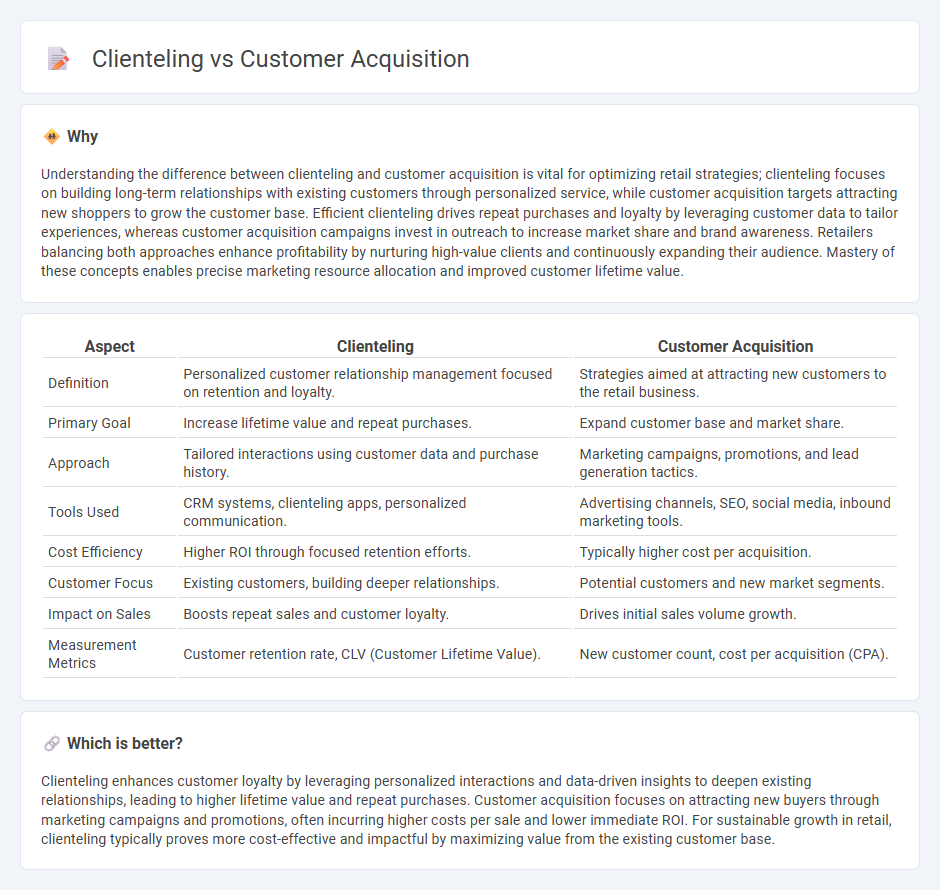
Clienteling focuses on building personalized relationships with existing customers to enhance loyalty and increase repeat sales through tailored recommendations and exclusive experiences. Customer acquisition targets attracting new prospects using marketing campaigns, promotions, and outreach to expand the customer base and drive revenue growth. Explore how combining clienteling and customer acquisition strategies boosts retail performance and customer lifetime value.
Why it is important
Understanding the difference between clienteling and customer acquisition is vital for optimizing retail strategies; clienteling focuses on building long-term relationships with existing customers through personalized service, while customer acquisition targets attracting new shoppers to grow the customer base. Efficient clienteling drives repeat purchases and loyalty by leveraging customer data to tailor experiences, whereas customer acquisition campaigns invest in outreach to increase market share and brand awareness. Retailers balancing both approaches enhance profitability by nurturing high-value clients and continuously expanding their audience. Mastery of these concepts enables precise marketing resource allocation and improved customer lifetime value.
Comparison Table
| Aspect | Clienteling | Customer Acquisition |
|---|---|---|
| Definition | Personalized customer relationship management focused on retention and loyalty. | Strategies aimed at attracting new customers to the retail business. |
| Primary Goal | Increase lifetime value and repeat purchases. | Expand customer base and market share. |
| Approach | Tailored interactions using customer data and purchase history. | Marketing campaigns, promotions, and lead generation tactics. |
| Tools Used | CRM systems, clienteling apps, personalized communication. | Advertising channels, SEO, social media, inbound marketing tools. |
| Cost Efficiency | Higher ROI through focused retention efforts. | Typically higher cost per acquisition. |
| Customer Focus | Existing customers, building deeper relationships. | Potential customers and new market segments. |
| Impact on Sales | Boosts repeat sales and customer loyalty. | Drives initial sales volume growth. |
| Measurement Metrics | Customer retention rate, CLV (Customer Lifetime Value). | New customer count, cost per acquisition (CPA). |
Which is better?
Clienteling enhances customer loyalty by leveraging personalized interactions and data-driven insights to deepen existing relationships, leading to higher lifetime value and repeat purchases. Customer acquisition focuses on attracting new buyers through marketing campaigns and promotions, often incurring higher costs per sale and lower immediate ROI. For sustainable growth in retail, clienteling typically proves more cost-effective and impactful by maximizing value from the existing customer base.
Connection
Clienteling enhances customer acquisition by leveraging personalized communication and tailored recommendations, which increase customer engagement and loyalty. Retailers using clienteling tools can analyze customer data to identify potential leads and convert them more effectively. This targeted approach improves acquisition efficiency and drives higher lifetime value for new customers.
Key Terms
Lead Generation
Customer acquisition emphasizes generating new leads through targeted marketing campaigns and conversion strategies, aiming to expand the overall customer base. Clienteling focuses on deepening relationships with existing clients by using personalized communication and tailored experiences to boost loyalty and repeat business. Explore detailed tactics for optimizing lead generation and maximizing customer lifetime value.
Personalization
Customer acquisition focuses on attracting new buyers through targeted marketing strategies, while clienteling emphasizes building personalized relationships with existing customers to enhance loyalty and lifetime value. Personalization in clienteling involves leveraging detailed customer data and purchase history to tailor communications and offers, creating a more engaging shopping experience. Discover how combining these approaches can maximize business growth and customer retention.
Relationship Management
Customer acquisition involves attracting new customers through targeted marketing strategies, while clienteling centers on nurturing existing customer relationships to enhance loyalty and lifetime value. Effective relationship management in clienteling uses personalized communication and tailored experiences based on customer data and preferences. Explore how optimizing these approaches can drive sustainable business growth.
Source and External Links
What is Customer Acquisition? - Customer acquisition involves strategies to attract and convert new customers into loyal advocates to ensure sustainable business growth, typically managed through marketing and sales collaboration using a process of attracting leads, nurturing them, and converting them across multiple channels.
5 Effective Customer Acquisition Strategies - Effective acquisition strategies are based on deep customer research using behavioral and feedback tools to understand and engage the right audience, fueling marketing efforts to attract, engage, and convert users into paying customers.
Customer acquisition strategies to grow your business - Key strategies for acquiring customers include SEO, content marketing, email marketing, and social media marketing, all designed to attract and engage target audiences effectively.
 dowidth.com
dowidth.com